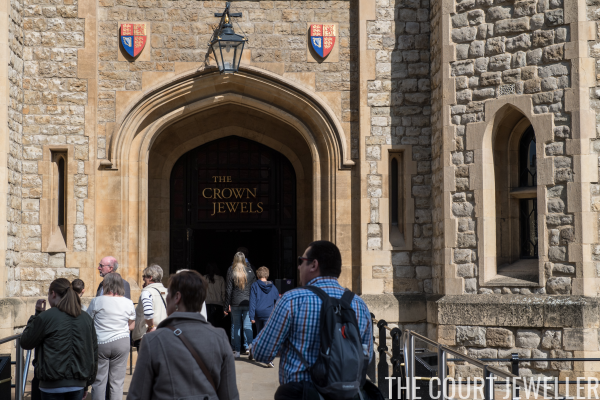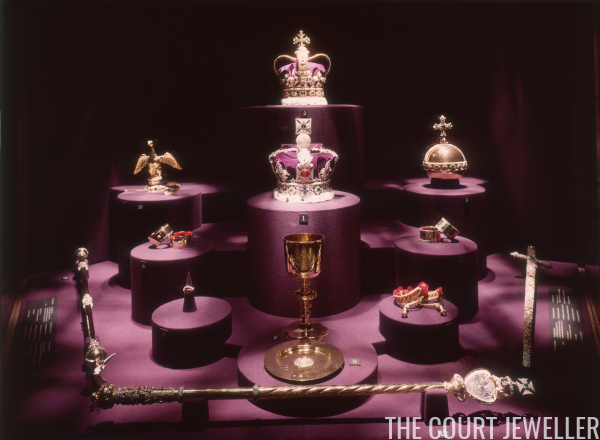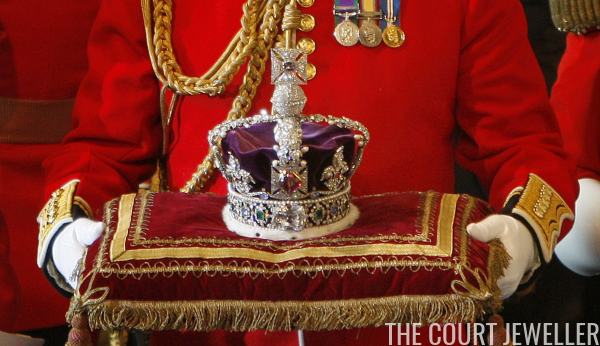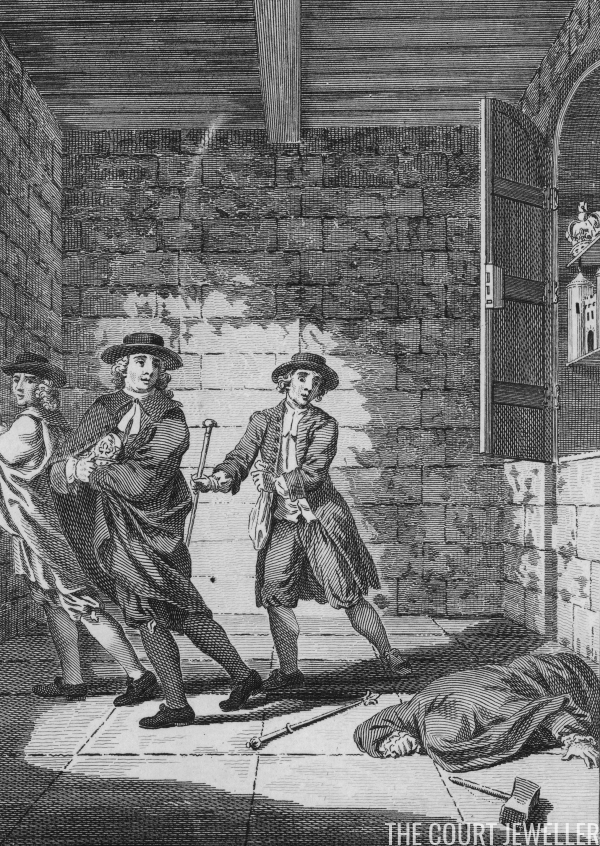 |
| Entrance to the Jewel House at the Tower of London, April 2017 (Chris J Ratcliffe/Getty Images) |
LONDON, Aug. 22 — The boss at the Tower of London confessed to Scotland Yard today that he set off the burglar alarm to see how well the crown jewels are being guarded.
“I’m delighted with the test,” said Brig. Leslie Frederick Ethelbert Wieler. “It worked extremely well.”
Brig. Wieler is resident governor of the ancient tower and the man responsible for safeguarding one of the world’s most fabulous collections of jewels [1].
“Why didn’t you warn us, sir, that it was only practice?” asked a Scotland Yard sleuth.
“What’s the use of having a test,” snapped the brigadier, “if it’s not carried out properly?”
It was carried out properly, all right.
 |
| The crown jewels on display at the Tower of London, ca. 1953 (Fox Photos/Getty Images) |
Shortly after breakfast the recorded voice on an automatic burglar alarm boomed out in Scotland Yard: “Intruders have entered the jewel house at the Tower of London.”
At the Tower itself, alarm gongs clanged like engines racing to a three-alarm fire.
Scots Guards jumped to action posts at the Tower … Scores of Yeoman warders lumbered to emergency stations … The flying squad roared out of Scotland Yard … Radio cars dashed to the Tower … Police boats churned down the Thames … Bobbies cordoned off Tower Hill … A 16-ton steel cage clanged down around the jewels.
It was the biggest scare since Capt. Peter Blood stole the royal ice from the Tower nearly 300 years ago [2].
 |
| The Imperial State Crown, including the Cullinan II Diamond, in 2007 (TOBY MELVILLE/AFP/Getty Images) |
All the jewels — which include the priceless Cullinan diamonds [3] and the Koh-i-Noor diamond [4] — were safe, of course. But, in revealing what happened, the governor let out a secret of the security arrangements surrounding the gem collection, viewed annually by more than 300,000 persons.
When Brig. Wieler broke an electric eye beam, the burglar alarm went off at the Tower and in Scotland Yard.
The recorded voice booming throughout the Yard was similar to hundreds of others in London. Instead of just clanging, it announces the address of the alarm.
Back at the Tower the Governor was happy.
“It’s been a perfect morning,” he said. “Now excuse me, please, I must show a party of Middle East sheikhs the jewels.”
 |
| In an engraving from Chamberlain’s History of London, Colonel Blood and his accomplices attempt to escape the Tower of London with the stolen crown jewels (Hulton Archive/Getty Images) |
Capt. Blood, a daring robber, almost got away with them. Dressed as clergymen, he and two associates gained entrance to the jewel house in the 17th century [5].
With a few well-directed blows they knocked out the guards and pocketed some of the gems. They dropped half their booty though as they galloped off on waiting horses.
They were overtaken and all but the Black Prince’s ruby [6] were recovered. Later this was found in the pocket of one of the gang.
Two hundred years later a woman got her hand through the steel bars and the glass and tried to yank out one of the crowns [7].
Guards caught her. They found her hand badly cut and the crown slightly scratched.
NOTES
1. Wieler served as the Resident Governor of the Tower of London from 1955 to 1961. Today, the Resident Governor also holds the title of Keeper of the Jewel House. The current governor is Colonel Richard Harrold.
2. Colonel Thomas (not Peter) Blood (1618-1680) attempted to steal the crown jewels from the Tower of London on May 9, 1671 after gaining the trust of the Master of the Jewel House over a period of several weeks. Blood and his accomplices damaged the jewels in the attempt, flattening St. Edward’s Crown with a mallet and cutting the Sovereign’s Sceptre with Cross in two with a file. However, they dropped the jewels as they attempted to flee. Blood was captured before he could escape the Tower grounds. King Charles II decided to pardon Blood, so he received no punishment for the attempted theft; historians argue about the reasons behind the king’s pardon.
3. Two of the Cullinan diamonds, the Cullinan I and Cullinan II, are set in the British crown jewels. Cullinan I (530.4 carats) is set in the Sovereign’s Sceptre with Cross, while the Cullinan II (317.4 carats) is mounted in the Imperial State Crown.
4. The Koh-i-Noor Diamond (105.6 carats) is currently set in the Queen Mother’s Crown. The means by which Queen Victoria acquired the diamond in the nineteenth-century are a major matter of debate, and the stone has been claimed by several other nations, including India and Pakistan. The British government maintains that the acquisition was legal.
5. Colonel Blood was indeed dressed as a parson during his attempt. The St. Edward’s Crown fell out of his clerical cloak during his attempted escape.
6. This enormous cabochon spinel (not a ruby) is currently mounted in the Imperial State Crown.
7. This story happened a bit differently in real life. In 1815, before the jewels were kept behind bars, a woman caused major damage to the St. Edward’s Crown, pulling apart the piece’s arches. The incident prompted a ban on viewers touching the jewels.
Leave a Reply